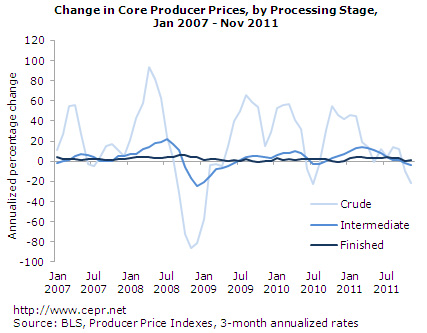December 16, 2011
December 16, 2011 (Prices Byte)
A rebounding dollar is restraining import prices.
The Consumer Price Index was unchanged in November and has grown at a 0.8 percent annualized rate over the last three months. Energy prices fell 1.6 percent last month — they are now below that of March of this year. Core inflation rose 0.2 percent, only slightly faster than the 0.1 percent reported in October (0.17 percent compared with 0.14 percent.) Over the last six months, core prices grew at a 2.2 percent annualized rate.
Food price inflation has decelerated in recent months — to a 2.3 percent annualized rate over the last three months, compared with 4.4 percent in the previous three months and 6.1 percent from February to May. Apparel prices rose 0.6 percent in November, and medical care continues to be a consistent source of inflation with a 0.4 percent jump in the month. Medical care inflation has run at a 4.4 percent annualized rate since August, compared with 1.5 percent for core prices overall.
Elsewhere in core goods and services, the price of personal computers and peripheral equipment jumped 0.7 percent in November — a very large increase for a category that almost always sees declines. This may well be the result of this summer’s flooding in Thailand, which has caused significant damage to factories that supply much of the world’s hard drives. Computers account for less than one-quarter of 1 percent of the consumer price index, so while interesting it is unlikely to have a significant impact on overall inflation.
The price of owners’ equivalent rent rose 0.1 percent in November and has now grown at a 1.9 percent annualized rate over the last three months. Rent of primary residences rose slightly faster, at 0.2 percent in the month.
Transportation prices fell for the second consecutive month — 0.8 percent after a fall of 1.1 percent in October. Much of the drop in transportation prices is the result of gasoline prices, which have fallen at a 10.3 percent annualized rate since August. However, the price of new vehicles also fell 0.3 percent in the month along with a 0.1 percent drop in the price of used cars and trucks. As discussed in previous reports, these movements are reversals of previous supply shocks and seasonal measurement issues the late model year.
Producer prices for finished goods rose 0.3 percent in November following a 0.3 percent fall in October. The main reason for last month’s inflation in this category was a 1.0 percent jump in food prices, which account for nearly one-fifth of the finished goods index. The price of core finished goods rose a modest 0.1 percent in November.
Price pressures at earlier stages of production continue to be weak. With a 0.4 percent fall in November, inflation in core intermediate goods has run at a negative 1.1 percent annualized over the last six months. Similarly, a 2.5 percent fall in core crude goods brought the category’s six month annualized rate of inflation down to -5.2 percent.

Some of this easing may be due to a rebound in the dollar, which has helped lower the price of imports. Since the dollar bottomed out in July, it has risen 4.8 percent. Outside of industrial fuels, inflation in import prices has been very low. Core prices rose at a 0.3 percent annualized rate since July—having fallen 0.1 and 0.3 percent in October and November. Similarly, core export prices fell 0.6 percent after last month’s fall of 0.9 percent.
Despite the low rate of inflation, the real hourly wage of employees fell $0.01 in November. Not only does this reduce the purchasing power of consumers but it makes it more difficult for them to pay off their debts– thereby decreasing demand for goods and services. Along with a rebounding dollar that helps keep import prices low, there continues to be weak inflationary pressures in the economy.






